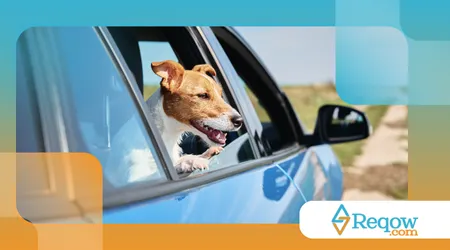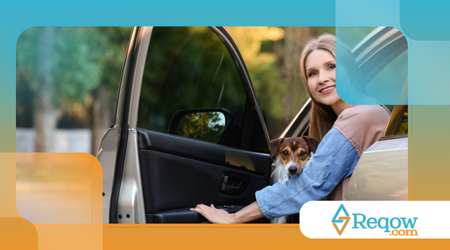Tips for teaching your dog to get in and out of the car calmly.

Teaching the dog how to get in and out of the car. The routine of going for car rides with your best friend can be stressful.
Advertisements
Many dogs exhibit anxiety or excessive excitement. Proper handling when entering and exiting the vehicle is crucial.
A pet's safety and well-being depend on calm and controlled behavior. Focused training resolves issues of euphoria and fear.
Why is being calm when getting in and out of the car so important?
A hurried or frightened dog can seriously injure itself. It may slip, jump into traffic, or damage the car's interior.
This agitation also increases the owner's stress, turning the walk into an obligation, not a pleasure. Safety always comes first.
Advertisements
Control at the exit prevents accidental escapes into unfamiliar areas. The dog must wait for permission from its owner to disembark.
Handling is an excellent exercise in self-control for the animal. It learns to regulate its own emotions, which is valuable in other situations.
How to Start Teaching a dog to get in and out of a car With Positive Reinforcement?
Training should be gradual and begin in a low-stimulus environment. Use high-value treats to motivate the dog.
The first step is to familiarize the dog with the car being parked and turned off. Leave the door open and let the pet explore the vehicle.
Read more: How to deal with possessive dogs regarding food.
Don't force it in. Place the treats inside, near the threshold, and gradually move them onto the seat. Let it decide whether to go in.
As soon as he puts his paws inside, celebrate with the command word, such as "Come in," and reward him.
Repetition in short sessions (maximum 5 minutes) builds a positive association. Calmness should be the absolute priority.
What's the best technique to get a dog to wait before getting out of the car?
The controlled exit is perhaps the most critical and dangerous point. Many dogs run out of the car as soon as the door opens.
The instructor should begin by teaching the hold command, such as "Stay" or "Wait," inside the car.
For example, open the door just a few inches and say "Stay." If the dog moves, close the door gently and repeat.
Find out more: Games that help with training and strengthen the bond
Reward him vigorously while he remains still with the door partially open. The door should only open fully if he remains calm.
The final permission to leave must be given with another command, such as "Go" or "Free". This teaches that leaving is a tutor's decision.

What to do if your dog is afraid (travel anxiety)?
Fear of vehicles is common and requires an even more delicate approach. Never force a frightened dog into a car.
The process of desensitization and counterconditioning is fundamental. The presence of the car should signal something good.
Serve the dog's meals near the car. Then, place the food inside the car with the doors open.
Look how interesting: Prevention of common diseases in apartment dogs
Turn on the engine for short periods while the dog eats or plays. Associate the noise with something relaxing and enjoyable.
Research Tufts University, Department of Animal Behavior (2023)Studies indicate that gradual desensitization reduces vehicle phobia in 75% of treated dogs.
Anxiety can be measured and monitored through behavior:
| Observed Behavior | Anxiety Level (Suggested Action) |
| Excessive yawning and licking | Mild (Continue desensitization) |
| Salivation, tremors, whimpering | Moderate (Reduce the intensity of the workout) |
| Vomiting, urination, escape attempts | Severe (Consult a veterinarian or specialist) |
(Source: Adaptation of animal behavioral assessment protocols)
This patient and positive approach is the basis for teach the dog to get in and out of the car in a healthy way.
Why is consistency the key to success in this training?
A dog's mind processes information through repetition and association. Inconsistency confuses and delays learning.
If one day you allow him to jump and the next day you demand that he wait, the lesson won't stick. The rule must always be the same.
Consistency acts like a firm fence in learning. It clearly defines the boundaries and the expected behavior.
Think of your dog as a staircase: He can only climb to the next step when he has mastered the previous one. Don't skip steps.
Teaching a dog to get in and out of a car It requires patience, but the result is a safer and more reliable partnership.

How to Avoid Common Mistakes and Enhance Calmness?
A common mistake is reinforcing excitement. If the dog jumps and receives affection, it understands that euphoria is the correct behavior.
Always reward calm behavior: All four paws on the ground, sitting or lying down, before and after the trip.
Therefore, this statistic indicates that 60% of canine injuries associated with cars occur at the moment of entering or exiting the vehicle.
Other original example To reinforce calm: Keep a blanket in the car that is only used on trips.
The familiar scent and texture help create a "safe haven" inside the vehicle.
When you go out, be prepared to be slower than your dog. Your calmness should be the key. rhythm which he should follow.
The Benefits of Teaching a dog to get in and out of a car In a Controlled Manner
Training isn't just about the car, but about impulse control. A well-controlled dog lives a better and safer life.
A dog that waits for permission becomes a more predictable and relaxed partner in any environment. Obedience is liberating.
This is an investment in the longevity of the relationship between the owner and the pet. The trip becomes a positive bonding experience.
The absence of stress makes all the difference. Wouldn't it be much more pleasant to enjoy travel without the chaos of arrival and departure?
With the correct method, the dog associates the vehicle not with anxiety, but with the opportunity to explore new places.
Master teach the dog to get in and out of the car It's about ensuring that every adventure begins and ends with complete safety.
Continuous training and rewarding good behavior reinforce the lesson. That's how we ensure a future of happy walks.
Frequently Asked Questions
Should I use an access ramp?
Yes, ramps are highly recommended, especially for large breeds, senior dogs, or dogs with joint problems (such as dysplasia).
The ramp minimizes impact on the limbs and facilitates controlled entry and exit, making the process more comfortable for the animal.
Can I punish him if he jumps out of the car?
No. Physical or verbal punishment increases fear and anxiety, hindering the training process.
Instead of punishing, simply remove the reward (close the door) and repeat the exercise calmly, requiring the child to wait and rewarding the correct behavior.
At what age should I start this training?
Ideally, familiarization (desensitization) training should begin with the puppy as early as possible, right after the vaccination period.
Young dogs are more adaptable, but patience and consistency allow you to teach a dog to get in and out of a car at any age.
